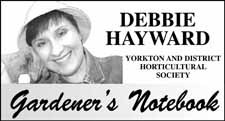Did you go to the book sale at the Yorkton Public Library last week? It's not like I don't have anything to read, but who can resist a book sale? I struck it lucky by finding a whole armload of gardening books, and one of them was a really interesting book that I want to tell you about.
"The Landscape Makeover Book: How to Bring New Life to an Old Yard" by Sara Jane von Trapp has all kinds of ideas on how to bring a little zip to our yards. You and I know that a garden is never really completed; we are always adding things, removing things, or rearranging things for a whole variety of reasons. But this book takes us beyond things like cutting back a tree that has grown too big, or replacing a perennial that has died out over the winter. This book has ideas on how we can rejuvenate our yards to make them look fresh and exciting!
One chapter that sounded interesting was "Reshaping the Planting Beds". Now there is something that we can all do in our gardens! My parents were great garden experimenters, and were lucky enough to have a roomy garden that could accommodate trying new things. One section that led out into their garden consisted of paths that wound around, and the flowerbeds were planted with an assortment of trees, shrubs, perennials, and pots of annuals. In the beginning, the paths were changed every few years to make more pleasing meanders through the garden, but one thing that remained constant was the fact that the flowerbeds never had a straight edge.
My parents did the right thing by instinct. As I read this chapter, it stated that geometric shapes are not as pleasing as curves, which echo nature and are more soothing. So that's our first tip: try to make curving edges to our flowerbeds. Even if you have straight edges now, drag out your garden hose and lay it on the grass in a curving pattern. Have broad sweeps to the curves: this looks more natural. And be generous in the size of the beds: not every bed has to be a three by six rectangle. Don't be afraid to cut into the grass and plant in layers, with taller plants at the back.
What plants to choose? One of our goals is to cover the foundation, but not block any windows, so for our back layer, we would probably want plants or shrubs that aren't above four to six feet. Ask at the greenhouse for plants that will fit this size, unless you want to be trimming down a shrub that wants to grow taller. Our middle layer of plants would be two to three feet, and will cover the stems of the back layer of plants. The front layer will be short, including annuals and perennials like various groundcovers.
If you are going to take the plunge and create an island flower bed, keep in mind that the tallest plants should be in the middle, and work down from there.
How do we cut our flower beds? We'll need a flat, sharp shovel, or an edger. (I'm not sure if that is the correct name for this implement, but Daddy had one that was in the shape of a half circle, and it was very sharp. He would cut through the grass in a line with this implement, then use a spade to pry out the clumps of sod.) You may be able to re-use the sod in another location.
Using a garden fork, dig up the soil to remove any rocks, twigs, or other debris. You might want to add some peat moss or compost or manure, and work it into the soil. Then comes the fun part: planting in the new plants. Lay them all our in the spot where they will live before you plant them, just to be sure you've got the right look.
I liked this chapter because no matter what size our yards are, this is something that we can do. Give it a try! Yorkton and District Horticultural members, remember that our next meeting is on June 20. This is a members only meeting at Skinner Garden Classics. For complete details, call Liz at 782-2830.
Have a great week and enjoy the warm weather and your garden!




